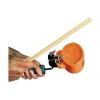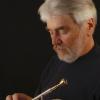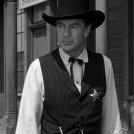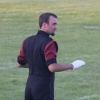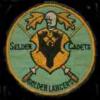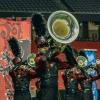Leaderboard
Popular Content
Showing content with the highest reputation on 03/11/2014 in all areas
-
So, so disagree with this. Fan Vote is cool, and I agree that DCI should use it for shows; but I think the fan vote should be a separate award. Make it a decent cash-prize, on top of a trophy or something, and make it worthwhile for corps to want it (i.e. something more substantial than the goofy Disney award they used to have). But making it part of the actual sheets wouldn't work, IMO. And I don't think there's anything wrong with keeping them separate. In 2010, for example, Blue Devils were without a doubt the best corps on the field and should've been rightly rewarded for their great design & performance. If, say, Madison Scouts were the fan favorite that year (I honestly don't remember, and it's likely a bit difficult to "quantify" fan favorite), then even though their design was well below Top 5, and their performance was well below Top 5, they should still be rightly recognized for their popularity. Keeping them separate, IMO, is the way to go (though ideally we would have more years like 2008 when the DCI Champion with a superior performance & design to its competitors is also the fan favorite).4 points
-
Here's a quick challenge. Go stand in front of Crown, or SCV, or Phantom, or Madison during horn warm-up, and let us all know if you think DCI has lost its edge and swagger.2 points
-
really? AFAICT the scouts are still the scouts. a couple of trombones doesn't change that.2 points
-
"Rocky Point Holiday," Garfield Cadets, 1983. From the first massive note to the ridiculous Z-pull at the end, it electrified a finals-night crowd that knew it was watching history. The chants of "East! East! East!" at the end were chilling.2 points
-
people are also entertained by watching a guy go thru 20 women to see who he'll marry people are also entertained by watching people do stuff like they do on jackass. people are entertained by late night tv entertainment cannot be universally defined Stu. You keep trying, but you keep failing2 points
-
put as much time required today ( especially caption heads )..leave home if needed for a very long time..lets see if you need to be paid...its not a time where someone went to practice, in the same town, for a few hours, went home etc etc...some people dont get enough. and the love is no different.. times are !!!!!oh yeah and the year2 points
-
Indeed, it is dangerous of me to suggest that we have reached the peak of the performance ability of the members. I don't know if it's true, but there's a story that, at some point in the late 1800s, a U.S. Patent Office official remarked that there was nothing left to be invented. Technology has reached its apex. The Fairchild Washing Machine was as good as it was going to get. Ahem. Crown's staff got a kind of sound out of their horn line last year that was something rarely, if ever, heard before. So perhaps there yet remains some "headroom," some place to innovate, elevate, and advance the drum-and-bugle-corps form that still resides in the physical -- meaning the same form, performed better. There may be room to follow Crown's lead, to push its teaching principles throughout all DCI horn lines and improve the sound of the brass across the activity, and maybe even to squeeze out some more volume. Batteries can, I suppose, continue to thin their books in response to ever-more-complex visual demands, or maybe there's a way to get them to play the thicker books of yesterday at today's levels of visual demand. I hope so. Such hopes reside in the quality of teaching, and the abilities of the performers. But I suspect we're running out of headroom. We've already about maxxed the tempos possible (or even desired). We long ago banished cymbals to the sideline, and maybe the next step is to banish timpani to the keyboards, and while we're at it maybe the bass line -- heck, the whole battery -- to electronics. It would make more marching spots available for brass. I'm being facetious, but the point remains: there is a functional limit to the horsepower you can get out of a DCI corps. The number of members is fixed. The season's length is fixed. The number of hours in a day is fixed. The type of instrumentation has been (mostly) fixed. The top end of the tempo spectrum is essentially fixed, and today's corps are spending more performance time than ever near that boundary. At fast tempos or slow, the lung capacity of a 20-year-old is fixed, and once a performer learns to use that maximum capacity, there is no more capacity to be had. If horsepower, then, can't be increased, how do you add power? Clarity? Tonal quality? Visual impact? Expressiveness? Musicality? You shrink the stage. Or change the instrumentation. Or the musical selections. Or the design. Or the rules. Or the whole point of the activity.2 points
-
OK. All clues point to a certain very prominent individual whose identity I should have known. As it stands, I hope he finds my earlier deductions amusing. Otherwise, he could have me thrown in the stockade. And yes, he flew in that rickety chopper, and commanded a tank unit, as well. The guy was the original Army of One. I salute you, Colonel. (Maybe I can get off with just some KP? If not, it wouldn't be the first time I lost a stripe.)2 points
-
2 points
-
I mean this as a legitimate question, and this is not an attempt to start up another trombone/French horn/Sousaphone thread: Why is no one - AFAIK - fighting to change British-style brass band instrumentation - a type of band/activity that is every bit as competitive as DCI (perhaps more) and been around since the mid-1800s? It seems like the arrangers/designers in that activity - again AFAIK - are perfectly content with the instrumentation and seem to have been for a really long time. Quite the opposite in DCI, though - why?1 point
-
With the 2014 season being the 80th anniversary in celebration of the founding of the Kilties by Mr. Raymond Vance in 1934; The Kilties got off with a rocky start but have bounced back with stellar attendance and progress at their recent February full corps camp. The corps' initial orientation camp the first weekend of December and the two following camps in January brought with it dangerous weather for travel even for the local area membership, and higher challenges for the out-of-town membership. The February 22nd and 23rd rehearsal camp was a complete turnaround with high attendance and excellent progress on the 2014 show (The Gathering) material, signature parade material and concert selections. The corps performed 50% of the 2014 production in full ensemble. The Kilties front percussion ensemble is presently full and closed for positions at this exact moment in time, the color guard will be closed soon with 24 positions already accounted for and attending rehearsals. The brass line still has openings for 2 sopranos, 1 mellophone, 2 baritones and 1 contra. The battery has 1 snare, 1 tenor and 1 bass position open. Although positions are still open in the brass and battery and it is strongly preferred to fill those few open positions, the corps is confident to presently go with the membership they have in place at this moment--as the corps itself is larger and of better quality than it has been in several seasons. Interested in membership in The Kilties, visit the corps' website and simply request more information. The website may be found here: http://www.kilties.com The Kilties next full corps rehearsal camp will be held on March 29th and 30th at Gilmore Middle School in Racine, Wisconsin.1 point
-
and thats the key to those who CHOOSE to do this...one can respect the past and the tradition WITHOUT being held back by it.1 point
-
Gotta throw a quick two cents in for '99 Vanguard. Fantastic both musically and visually. To take it back a bit, '74 Vanguard doing the fugue from Britten's Young Person's Guide is some of the best musicianship I've ever heard on a field, and I've only ever heard the recordings.1 point
-
well you know they dont wear spats anymore.....what next.................... lol1 point
-
1 point
-
I'm sure I could think of more, but these two come to mind immediately. 2002 Crossmen's Heat of the Day, opening drill sequence with the brass entering the tunnel and onto the field is boss, whole opener is just 3 minutes of in your face awesomeness. 2002 Vanguard's Trivandrum. One of my favorites, classic Vanguard IMO.1 point
-
gottcha...OC just needs less talk and more action from supporters and if that doesnt happen , well, we know where that will go1 point
-
1 point
-
While I don't particularly object to Madison using trombones, by your argument,* drum corps should never have played 99% of the music that's been put on the field, since almost none of it was written originally for their instrumentation. (Barber's "Adagio for Strings" just doesn't sound correct without, well, strings, which is why the piece was such a disaster for SCV 2000, Buccaneers 2005, and Cadets 2013.) But 2muchcoffeeman has already said this much better than I could. *Allowing that your use of scare quotes perhaps suggests you don't really believe the argument yourself. That's kind of a fallacy, especially considering: 1) Barber composed a choral version ("Agnus Dei"), not just "for strings." Actually, that was the version SCV used as their source in 2000. 2) we're talking about re-orchestrating instrumentation/re-voicing a composition that is fairly simplistic in nature. Replicating a voice/color that doesn't exist elsewhere is another challenge entirely. The trombone gliss is a pretty integral color for the piece in question: a color that is literally impossible to replicate on anything other than a trombone or a synth. In DCI I think it's against the rules to replicate a brass instrument on synth (could be wrong, but that's how I remember the rule), so it makes sense that Madison would want to include the trombone voice as part of their show. Would the composition/arrangement work w/out the trombone? Probably. Would the composition/arrange work BETTER/sound cooler with the trombone? Probably. I don't fault any composer for wanting to use as many musical colors as they want. Visual designers have no limitations on props, equipment, etc; percussion arrangers have zero limitations as well. Why handcuff the brass arrangers? I must have missed the fact that SCV sang "Adagio for Strings" / "Agnus Dei" instead of playing it on their horns. And I'm sure that the trombone is more essential to a drum corps version of this Stan Kenton piece than the solo violin is to a drum corps version of Scheherazade. SCV 2004 was OK without that instrumentation, but it would have worked better/sounded cooler if only they'd included that voice. Or maybe the difference is that Rimsky-Korsakov (and Tchaikovsky, and Shostakovich, and Bartok, and...) is more "simplistic" than Kenton? I mean, why handcuff drum corps' wind arrangers by restricting them to brass? Why handcuff any arrangers by not letting them add real strings? I'm sorry, but did you not understand the intent of what I wrote? I don't mean that in a facetious or snide way, but seriously you quoted/bolded parts of what I said while seemingly missing the ENTIRE point of what I said. My original point about SCV was that their SOURCE music was from a choral version of “Adagio” that Barber composed. My point was when I quoted you, you very smugly stated: “Barber's "Adagio for Strings" just doesn't sound correct without, well, strings, which is why the piece was such a disaster for SCV 2000, Buccaneers 2005, and Cadets 2013.)” I was correcting your wrong statement that “‘Adagio for Strings’ doesn't sound correct without strings": “Agnus Dei”, a choral piece, sounds amazing without strings. But that's kind of moot because WE'RE TALKING [sHOUTING] ABOUT RE-VOICING! I can arrange/transcribe "On a Hymnsong of Philip Bliss" for percussion ensemble and put every note, articulation and dynamic on the page, and then conduct it to mimic the phrasing that Dr. Holsinger does when he conducts. Similarly SCV's arrangers can transcribe nearly every melodic motif of "Scheherazade" for brass and percussion. While it would sound different timbre-wise, it would be all the same notes, etc. A trombone glissando cannot be replicated on any other instrument except maybe a sampled synth. I can understand why Madison's designers would fight for that inclusion, especially since there are no limitations for percussion. One funny thing about this conversation is that I own a CD that consists entirely of eight or nine different arrangements of the “Adagio for Strings”. And I knew that SCV’s version was in fact an adaption to drum corps of Barber’s choral “Agnus Dei” derived from the “Adagio” (whose best-known string orchestra version is itself an adaption from what he first wrote for string quartet). So I know quite well that the piece, like a great many other compositions, can be translated very effectively to other idioms than that for which they were originally created. This is in fact the essence of drum corps. Notice what Barber did not do: he didn’t arrange it for voices and then try to pass it off as a work for string orchestra. (Maybe the problem is that you didn't realize I was being sarcastic when I said that the "Adagio" doesn't sound correct without strings?) Furthermore, I simply disagree with you that the trombone alone possesses a sound for which it would be, to cite Joe Allison’s ridiculous term once more, “sacrilege” to replace with something else on the field; that the sound of the trombone, even counting the glissando (or portamento), is more unlike a euphonium’s than the sound of a violin is unlike a trumpet’s. Again, not that it matters if one ensemble has nothing that sounds like another, when it comes time to adapt. Few people would mistake the human voice for a viola, but that didn’t stop Barber from making the arrangement in question. (As it happens, I admit I wasn’t very familiar with the “Concerto to End All Concertos” before yesterday, but after listening to it three times on Youtube, I have yet to hear the part that must be performed on trombone. There’s a lot of descending trombone lines, and I guess they slip into each note rather than hitting it square on, but nothing I can hear that slides from one note to another so dramatically that a euphonium would sound especially wrong—if I were even to agree that it was wrong for the euphonium to sound different. What am I missing? Can someone point me to the key moments in that recording?) To step back a little, it seems to me that the basic point of disagreement between the two camps in this discussion is as follows: One position holds that drum and bugle corps are a specific kind of marching musical ensemble, like a piano trio, or a barbershop quartet, or a brass quintet are specific kinds of non-marching music ensembles, and drum corps therefore should be limited to a certain instrumentation. No one on these forums would claim a string quartet with a euphonium instead of a cello was still a string quartet. The other position holds that drum and bugle corps are any kind of marching musical ensemble, including the above mentioned combos as well as any other imaginable, and therefore all instrumentation should be permitted. No one on these forums would claim that a violin / violin / viola / euphonium quartet wasn’t a musical group. The first position has been best exemplified by 2muchcoffeeman’s post, which everyone should read, and to which nobody posted anything in disagreement. But I think you actually do disagree. Is that right?1 point
-
Similar in the nature of adjudication in some respects, but not the same in terms of the fundamental nature of what those things are and what drum corps is due to the whole live musical performance thing. And yes I do believe it makes a huge difference. Around and around we go. We've covered this already. You and I will simply not agree on this. Let's move on.1 point
-
I found it interesting when i read the comments about BoA and the West Coast. BITD when I was in HS- MBA (What BoA was originally called) had the Live Oak "Emerald Regime" out of Morgan Hill, CA as it's 800 pound gorilla. IIRC, Pete Emmons was their visual person or at least did the drill design. As previously pointed out at least some of the WC bands able to afford a BoA type of experience are coming out and doing well.1 point
-
You were. The two posts in question read as sheer insult and not humorous to me, and I'm someone who is very often frustrated by your debating style. (Try not to go cosmic* so much.) Nonetheless, I suggest you be the bigger man and move on. *Edit: By that I mean not that you question the idea that there is such a thing as truth, but that (in pursuit of pretty much the opposite position) you too frequently try to enlarge the terms of the debate to a scale that loses sight of the specifics under discussion. How many people did you think were prepared to discuss drum corps in terms of Existentialism, for instance?1 point
-
Yes and no. At the end of the day, no matter how good a corps is, one drum corps cannot directly prevent another drum corps from being better. There is no defense in drum corps.1 point
-
No that's not what I said. And there's a substantial difference in meaning between the expressions. Your failure to even recall such a simple fact leads me to believe you have no idea what people are actually writing but instead remember your own interpretations of posts. It's kind of like conversing with a someone through a translator who's deliberately changing content without either party knowing. I think it's best if you just stop replying to my posts and I'll do likewise.1 point
-
1 point
-
Right, and to be more simplistic, HS's have a pretty wide range of spending budgets, depending on boosters. A band with a smaller budget is going to have a hard time competing in a circuit that is GE-heavy. Having musical focused sheets kind of helps level the play the field a little bit.1 point
-
Made me remember an incident at our HS a number of years ago. One of the students left his drill charts at the HS field after a morning practice before a game. A football coach found it an brought it to the staff...he said something to the effect of " Gee, one of the kids left his book on the field. We don't want the other bands to see what we're doing!"1 point
-
what do you actually think is going to change...nothing..........................fan vote is fine as long as it has nothing to do with score........fan votes dont mean the best wins1 point
-
1 point
-
Yeah, the article was really written poorly, IMO. There was no real explanation other than really nebulous rhetoric about GE judges being able to appreciate a wow moment. I'm always hesitant to get too excited over that type of fluff-speak, so we'll see how this plays out. I know if I was a staffer and felt like an Effect judge was talking out-of-caption in a negative way, and/or in a way I thought they were not qualified to speak, I would not be happy. That all being said, I'm going to assume that this is all much more clear cut as far as training goes, explanation to the corps, etc. and this garbage of an article was written down for the fans to try to hype it up a bit. I did smirk, as I kind of thought something to the effect of, "uh-oh BD-haters: potentially more to love on the GE sheets for their designs!"1 point
-
If they want judges to view more like audience members, how about getting rid of the corps' video explanations to judges preseason? Let them try to puzzle out what in the world is going on in some of the shows, just like the rest of us. Mike1 point
-
As usual, a poorly-thought-out and inaccurate sports analogy that falls flat on it's face. Just a few points that are immediately obvious... I didn't say 'teams design their playbooks not for audiences" -- it was '"Corps design shows not just for audiences but for those performers." Your change completey alters the meaning of my sentence. Basketball is not a performing art. Playbooks are not musical scores. Playbooks ARE written to reflect the talent and abilities of the performers (as well as the current "state of basketball" ie how the game is played now versus in a different era). Basketball teams compete directly (head-to-head) against their competitors. If you don't think basketball (and the NCAA) have changed since 1980, I might just be forced to post that picture. Again.1 point
-
DCA has an excellent alumni corps show as part of their championship weekend. Every year there's a showing of corps doing exactly this, dusting off the old uniforms and old charts and putting on a great show for the people who love old school drum corps. I highly recommend it if that's your thing.1 point
-
I remember when the same thing happened to Drum Corps Midwest. The big corps went off and did their own thing. How'd that work out for DCM?1 point
-
You're going to need to illustrate an example. How can "real dirt" on DCI be used advantageously?1 point
-
Here is what really bites me about DCP discussions. When we bring up the aspect of DCI being entertainment many people on DCP say no, no, no, it is a competitive activity and therefore not like other music groups such as Rush; and when we bring up the competitive aspect of DCI many people then bark and say, no, no, no, we should not compare DCI to competitive activities like Figure Skating. Gee Whiz Y’All!!!!!1 point
-
Thanks for the information about SCVC's show. That should go in the Open Class forum; I'll start a 2014 Program thread there.1 point
-
From my experience with listening to DCI GE tapes the judges already considers the audience. There will be comments like "wow, the crowd is really getting into it" or "you didn't quite excite the crowd in the way you were anticipating". A lot of their analysis is technical yes but if a corps is really kicking ### they can't help but have their inner "fan" reaction to a show. Plus, I'm not really sure how a judge in "judge-mode" will have a different opinion than the same judge in "audience member-mode". Cesario says that without this change we were putting judges in a box... but realistically these judges aren't segregating their thoughts like this. Maybe its easier to tell the public that the judges will consider "this" or "that" than it is to say that maybe the GE judge actually really enjoyed the Blue Devils rendition of DADA or Through a Glass Darkly. It's clearly a superficial change.1 point
-
1 point
-
Heh... I wonder what the Glassmen kids thought of Pepe's knock-the-walls-down sound at the end of that tune!!! LOL1 point
-
1 point
-
Do you know what a glissando sounds like? If that is a desired effect, what instrument could replicate the idea. A note-to-note transcription is just slightly different than a musical effect. But good stab at criticsim.1 point
-
Nanci once asked if there was anybody I didn't know. I told her there's plenty and this is one of them. However, I believe I can throw out the initials J.L. and be a wee bit confident. Thanks to the clues...1 point
-
Since we're all trying on theories, how's this one, still only half baked: Someone mentioned the early '80s, exemplified by '83 Garfield, as an era when innovation in the expression of drum and bugle corps was plain to see and hear, and was enthusiastically received by the mass audience. For purposes of this theory, I'll push back that era to the late '70s, when SCV introduced assymetrical design. Trophies were raining down on Vanguard in those days, and crowds leaned forward whenever they stepped on the field. They did the same with Garfield, whose brass technique, show design and approach to marching pointed the entire activity in a new direction. My hypothesis: The innovation of the late '70s and early '80s accelerated drum and bugle corps participants -- the kids on the field -- toward the limits of what a human body can do in the service of performing as a musical ensemble in motion on a football field. We have reached those limits, and further innovation in drum and bugle corps necessarily involves elements of art that are less tangible and much more open to interpretation, thus debate, thus ambivalence among the audience. That's the theory. The evidence: Tempos are up. Santa Clara stepped off the line at finals in 1981 at about 138 beats per minute. Later, in the same show, they cranked it up to 160 and briefly touched about 182 -- while parked in a concert set. In 1983, Garfield charged off the line and through the "Z-pull" at about 182, and DCI has had the foot on the accelerator ever since. Thirty years ago, the boundary used to be the far reaches of allegro. Today corps spend much of their time, on the move, at presto. From the start, you could see some of the effect on the drill. It became more follow-me, less dress-and-cover. More about individual responsibility, less about relationship to the form. And you could hear it in the music, especially in the battery. The Blue Devils in 1982 roared to the end of their opener at 132 bpm. The snare line was spitting fire, all 32nd-note rolls and what us dinos call "singles," or 24th-note sextuplets. The battery music was thick, thick, thick with notes -- and boy howdy it was c-l-e-a-n. Spirit's drum line of that era was the same; it seemed to be a contest which line could cram more notes into each measure. It was the stuff that made wannabe DCI drummers like me swoon. In 2014, you'll listen long and hard before you hear an honest-to-God single coming from a snare line. It was hard enough to get clean when you were marching 12 snares elbow-to-elbow in a straight line at 132. At today's tempos, with snare drums (usually only 8 or 9) scattered across the field, it's #### near impossible. Today's battery music is much more duple-based. Rolls, conversely, are much more likely to be 24th-note vs. the 32nd-note rolls of the older, slower, era. Today's battery music is less dense, but much faster, with much more drill demand. The change in the approach to brass has been even more dramatic. The early '80s introduced Donnie Van Doren's "breathe-dah" approach to playing on the field, and of course the instruments themselves have changed. It all improved tonality, balance and the overall quality of the brass sound in the activity, though perhaps at the expense of volume. According to my half-baked theory, for much of the past 30 years audience response to these changes has been generally enthusiastic. Why? Because fans saw the same activity -- bang drums, blow horns, spin flags -- but they saw it at faster tempos and with more complex, stimulating design. Company fronts formed out of nowhere (cool!) and then dissolved (even more cool!). The music was still largely familiar and accessible, but the activity was pushing the frontier of what a performer could achieve in terms of musicality, demand, expression. We could all relate to what the performers were doing -- pushing themselves to the upper reaches of their capability. We could cheer that, just as we cheer a sprinter who sets a world record in the most ancient and familiar of contests, the 100-meter dash. It's the same activity, performed to a superlative degree. One of the reaons why baseball was so cherished by so many for so long was that so many of its fans grew up playing the game. They could relate to the major-leaguers on some level because they were running the same bases and swinging the same bats. In a similar way (the theory goes), as long as innovation in drum corps resided in the realm of the physical, fans could relate to it. But there comes a limt to how fast you can move and play a horn with quality, to say nothing of having any air at all to supply to the instrument. There's a limit to lung capacity and aerobic demand, and the increased emphasis in modern drum corps on physical fitness is one piece of evidence that innovation during the past 30 years has come from maximizing the physical capability of the performers. Still, there's a limit to how fast the hands can throw down the sticks and maintain a cohesive ensemble sound that projects clarity and musicality across a large distance -- from the field to the press box. No other ensemble musical form demands so much projection of music across so great a distance. We've already passed the boundary where the body, if it is to cover as much ground as quickly as today's drill demands, must abandon military bearing and adopt dance technique. My theory says drum corps has moved closer to those limits during the past 30 years than it did during from its inception to 1980. Maybe I'm wrong about that, but really, how much faster than 184 or 200 bpm can a human march? How much faster than 184 or 208 does a listener want to hear? The upper limit of musicality, according to most metronomes, is 208. Today's drum corps spend much of their time on the field in close proximity to that limit. (Of course, today's corps play plenty of music at adante and adagio tempos, and indeed, some of the most beautiful and memorable brass moments come during ballads. But the theory, I think, still holds, if the activity has reached the physical limits of what can be achieved by 80 horns on a field. Perhaps there are advancements in technique or music education that will squeeze mo' betta' out of horn lines at these slower tempos, and possibly faster tempos, but as far as I'm aware, the "breathe-dah" approach to marching brass first mastered by Garfield in the early 80s remains the fundamental principle). So, where will innovation come from? As innovation leaves the realm of the physical, it enters the realm of the intellectual. It has left the realm of tempo, drill, and musical technique, and has entered the realm of design, theme, and meaning. There isn't much left to squeeze out of 80 horns spread across a football field already zooming around at 184, so innovation comes from new rules, new instruments, new themes and concepts. The programming moves from the familiar and accessible to the esoteric. From the fan's perspective, this is no longer innovation within a familiar form, but an entirely new form. It's no longer new kids doing the same thing only better; it's new kids doing different things. No wonder a lot of fans sit on their hands.1 point
-
If Joe Allison wants to contend that the Madison '88 baritone solo would have been "more idiomatic" with a trombone, and that a high school wind ensemble which played one of the Holst suites with nine bell-front euphoniums and no trombones is "sacrilege", that is of course his right to hold those opinions. But we need to ask him to please be consistent: Unless he desires to be hypocritical, if a drum corps does the Rite of Spring solo on anything other than a bassoon it thus, by his standards, would not be idiomatic; moreover, by his standards, any drum corps which played Barber’s Adagio for Strings on Brass instruments would also be a sacrilege; and that also means that to him any corps which performs any work by Philip Glass out of original context would be an abomination. So, unless he is in line with those constancies, his ‘sacrilege’ and ‘idiomatic’ statements are, well, bunk.1 point
-
1 point
-
Just as a note; creativity is doing more with less, not more with more.1 point
-
For the modern era that's what I was going to say, 2013 appeared to be a notch or two easier visually, but it also cleaned MUCH better than 2012 which was just insane.1 point
-
At the time, BD 76 was considered difficult and don't discount the real old days when there were no marked yard linds other than the perimeter and the 501 point
-
1 point
This leaderboard is set to Chicago/GMT-05:00


